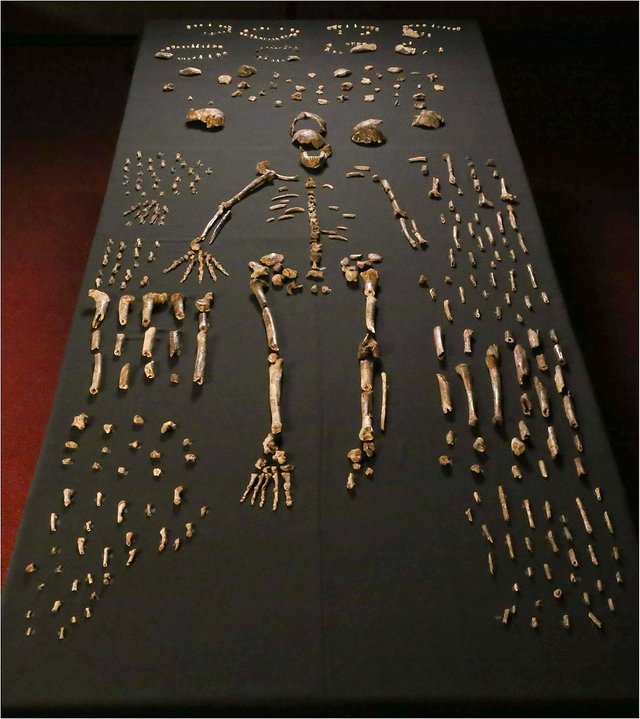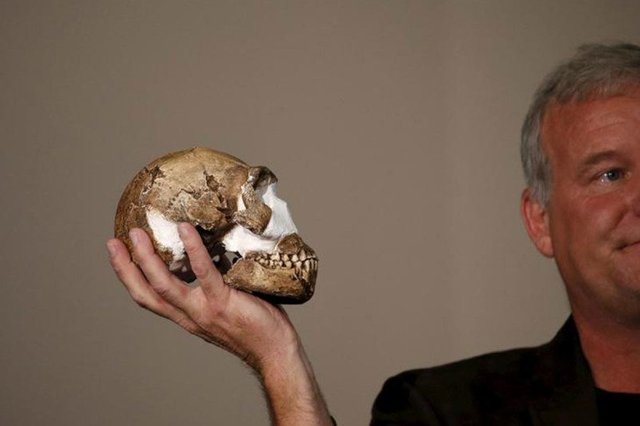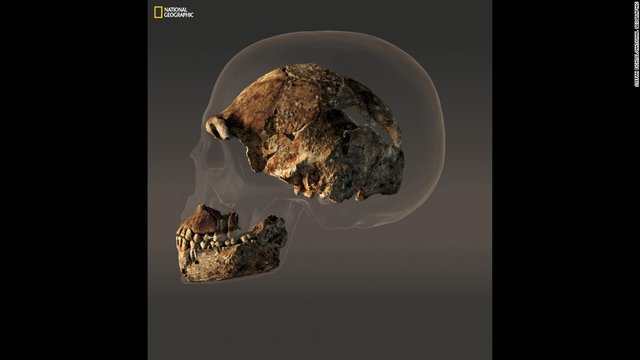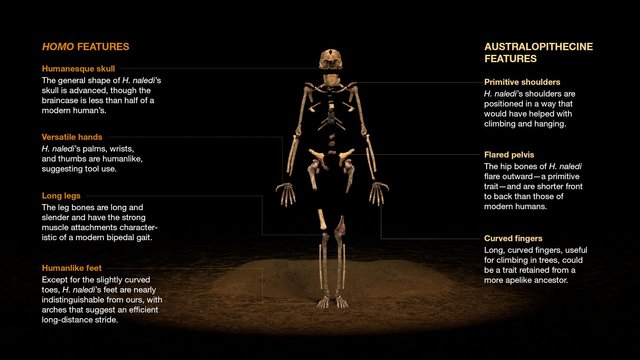Last week I covered a lot of the background to the questions being raised by the Homo Naledi finds in the Rising Star cave system. Here is a refresher with pictures followed by the dating methods and further perplexities.
From this picture you can get the impression of just how small the brain of Homo Naledi is.
This superimposes the scull for comparison with a Modern human skull.
This shot is basically only half of the better preserves skeletal remains that were uncovered at the first chamber and excavation site.
Excavations at the second chamber has produces an even more complete skeleton of an individual specimen named Neo.

By Lee Roger Berger research team - http://elifesciences.org/content/4/e09560, CC BY 4.0, Link
And here is a nice graphic I found covering the mixture of Modern and primitive traits
After the first discovery the world was reeling from the possibility that this seemingly primitive species could have been burying their dead.
The second chamber further confirms this but the real shocker was yet to come when dating was finally complete.
The age estimate for the fossils is between 236,000 and 335,000 years old .
This is jaw dropping because it puts these specimens at or around when modern humans were around in the same place.
This is totally counter to the previous thinking, that as more modern species evolved they out-competed their smaller brained ancestors and totally replaced them.
The dating was done both of the fossils and the surrounding materials in the cave.
Below is a picture of material extracted from freshly broken teeth, from both dentine and enamel for various types of isotope dating.
Flowstones were also dated as they capped or contained layers of fossils.
Flowstones are very interesting as they are calcium deposited by dripping water.
They are not always present and deposited continuously. During times of drought and dry climatic cycles no dripping inside the cave occurs and no flowstones, stalagmites and stalactites are deposited. So the different layers deposited during wet periods can be thousands of years apart and preserve snapshots of how the cave interior changes over time.
These can also be accurately dated and correlate with the dates determined from the teeth.
This picture shows how the cave changed over time as revealed by the flowstones.
The dating results are pretty much irrefutable and so this is what is turning current consensus on its head.
Here we have a species that should have been long extinct possibly living alongside and interacting with modern humans.
Its long been suspected an modern genetics has strengthened the conclusion that modern humans are a relict species.
Genetics and the fossil record together suggest that the ancestors of modern humans evolved in Africa amid a diversity of hominin populations and species, which shared many aspects of the human adaptive pattern.
We have the Sahara desert in North Africa that prevents northward migrations during dry cycles and then allows it during wet climate cycles. Species that have migrated north during the wet cycle are pushed further northward as the next dry cycle starts and the desert expands. Eventually these are forced into Europe and Asia via the middle east where they can spread out to Europe and Asia.
Similarly in central Africa we have the Tropical Forest that expands and contracts with wet and dry cycles.
This pins down and prevents the migration of savanna and savanna woodland species(homonins) to specific periods of climatic cycles.
Its these feast and famine, isolation and mixing cycles that drives the diversity we see in the Hominin fossil record.
Even in modern human populations the indigenous populations of Sub-equatorial Africa demonstrate the greatest genetic diversity.
The teeth of homo naledi would indicate that they shared a similar high-quality diet to modern humans.
The wrist and hands would be capable of making and using tools like the modern humans they may have been living around and interacting with. Now it is no longer certain who was making the tools found strewn widely across Southern Africa. Naledi could be responsible for some of them.
Since humans are a relict species with many contributions to its gene pool it is now wondered if, when and where homo naledi contributed to that pool. We have already seen with the sequencing of the Neanderthal genome that as much as 5% to 10% of our genes come from them and these genes are most prevalent in European populations.
The mix and match of primitive anatomy could even begin to hint at hybridization further up the ancestral lines.
An alternative hypothesis for the homoplastic appearance of H. naledi is hybridization among two or more hominin lineages. As ancient DNA evidence has grown, it has become clear that hybridization among genetically distant human lineages occurred many times (Kuhlwilm et al., 2016; Meyer et al., 2012; Prüfer et al., 2014), as is the case in chimpanzees and bonobos (de Manuel et al., 2016) and in many other mammalian lineages (Schaefer et al., 2016). The mosaic anatomy of H. naledi, which includes many shared derived characters of modern humans and H. erectus, might suggest the hypothesis that H. naledi resulted from the hybridization of a more human-like population and a late-surviving australopith.
With these papers only a year or two old and much research to still be done and published these finds are stirring up whole new debates and lines of thinking and challenging long held notions about human evolution.
Sources:
The age of Homo naledi and associated sediments in the Rising Star Cave, South Africa
Homo naledi and Pleistocene hominin evolution in subequatorial Africa






So excited genetics, archaeology and other sciences are involved in this project. We have yet to discover more and more about our past. This is just the beginning. Future tech will give us many opportunities to realize our past - maybe we can see Neander clone in the future :)
Downvoting a post can decrease pending rewards and make it less visible. Common reasons:
Submit
A Neander clone would be cool but have interesting ethical implications
Downvoting a post can decrease pending rewards and make it less visible. Common reasons:
Submit
Great article!
I'm positive we're gona find all kinds of new discoveries...
Downvoting a post can decrease pending rewards and make it less visible. Common reasons:
Submit
For sure
Downvoting a post can decrease pending rewards and make it less visible. Common reasons:
Submit
Excellen post! Many scientific research believe that that modern humans originated in Africa, and they continued to evolve in Africa and had spread to the Middle East . It is possible that homo naledi could be the first of modern humans. And i believe without any doubt "Adam" is the first man in existence on this earth.
Downvoting a post can decrease pending rewards and make it less visible. Common reasons:
Submit
The Rising Star Cave in South Africa? Wow, I've never heard of this until now. I wonder if this has been mentioned on Ancient Aliens? This is, truly, fascinating.
Best Regards
Downvoting a post can decrease pending rewards and make it less visible. Common reasons:
Submit
Downvoting a post can decrease pending rewards and make it less visible. Common reasons:
Submit
Excellent post. Interesting findings and more to come!
Downvoting a post can decrease pending rewards and make it less visible. Common reasons:
Submit
Fantastic article!
Upvoted and resteemed
Downvoting a post can decrease pending rewards and make it less visible. Common reasons:
Submit
Every human should be following this story, it's great to find out we don't know it all at all!
Downvoting a post can decrease pending rewards and make it less visible. Common reasons:
Submit
Interesting... this is worth a second look.
Downvoting a post can decrease pending rewards and make it less visible. Common reasons:
Submit
Very much knowledge base post. Thanks for the valuable information about the man's existence on earth .Upvoted .
Downvoting a post can decrease pending rewards and make it less visible. Common reasons:
Submit
thanks
Downvoting a post can decrease pending rewards and make it less visible. Common reasons:
Submit
Welcome.
Downvoting a post can decrease pending rewards and make it less visible. Common reasons:
Submit
Pretty cool that we're digging up the Flintstones
Downvoting a post can decrease pending rewards and make it less visible. Common reasons:
Submit
This would appear to be Fred's great grandma twice removed, possibly with a little hillbilly mixed in.
Downvoting a post can decrease pending rewards and make it less visible. Common reasons:
Submit
Good post
Downvoting a post can decrease pending rewards and make it less visible. Common reasons:
Submit
Interesting article , hope to see more good posts !
Downvoting a post can decrease pending rewards and make it less visible. Common reasons:
Submit
Very Informative. Thanks for sharing. Upvoted.
Do visit mine post as well.
https://steemit.com/language/@archerized/world-most-famous-and-top-rated-languages
Downvoting a post can decrease pending rewards and make it less visible. Common reasons:
Submit
Interesting.
If Naledi could live Sapiens it can also mean that Naledi could have survived and Sapiens got distinct. If this possibility exists, it means it might have happened and that we are not the descendants of "most intelligent" Homo species. So, far no bones discovered to proof us not to be, but the possibility exist.
Downvoting a post can decrease pending rewards and make it less visible. Common reasons:
Submit
no we are Sapiens and are very unlike Naledi, naledi just has some very human like characteristics.
Downvoting a post can decrease pending rewards and make it less visible. Common reasons:
Submit
Thanks for posting this @gavvet. Evolution themes always fascinate me.
Here is how the evolution from a minnow to bigger one on Steemit looks like :D:
Downvoting a post can decrease pending rewards and make it less visible. Common reasons:
Submit
there is always a chance for a new discovery to invalidate the previous findings. so much unexplored stuff still out there!
Downvoting a post can decrease pending rewards and make it less visible. Common reasons:
Submit
plenty for sure
Downvoting a post can decrease pending rewards and make it less visible. Common reasons:
Submit
It wouldn't surprise me at all if some of the tools found came from Naledi. This species looks very similar to modern humans! It will be interesting to see if they discover anything else from the Rising Star Cave! Thanks for sharing this!
Downvoting a post can decrease pending rewards and make it less visible. Common reasons:
Submit
It has over 2 km of mapped tunnels
Downvoting a post can decrease pending rewards and make it less visible. Common reasons:
Submit
Wow! That seems massive!!
Downvoting a post can decrease pending rewards and make it less visible. Common reasons:
Submit
Its a labyrinth.
Downvoting a post can decrease pending rewards and make it less visible. Common reasons:
Submit
💀👍🏼
Downvoting a post can decrease pending rewards and make it less visible. Common reasons:
Submit
Really intriguing article! It will be interesting to see what more comes from this discovery. Thanks for sharing!
Downvoting a post can decrease pending rewards and make it less visible. Common reasons:
Submit
I hear not having smart phones is what did them in!
Downvoting a post can decrease pending rewards and make it less visible. Common reasons:
Submit
or perhaps the radiation cooked their orange sized brains... ;)
Downvoting a post can decrease pending rewards and make it less visible. Common reasons:
Submit
Very interesting piece of information. I was surprised to know even the teeth are examined to come to the conclusion of the diet they followed. Simply blown away by the advancement of technology and human knowledge. Great post . Cheers!!!!!!!
Downvoting a post can decrease pending rewards and make it less visible. Common reasons:
Submit
yup, you can even find fossil bits of food in tartar on teeth
Downvoting a post can decrease pending rewards and make it less visible. Common reasons:
Submit
This is a really fascinating discovery. That 335,000 year timeframe certainly raised my eyebrow.
Curious to hear your thoughts on this (paging @benfink - brother / primatologist)
Downvoting a post can decrease pending rewards and make it less visible. Common reasons:
Submit
Great collection of images and information @gavvet!
Naledi might be super important going forward so long as those dates are accepted. I think some researchers are still skeptical, and suspect the H. naledi fossils may have been deposited in the rising star cave (the specific chamber) perhaps long after their death. This would make the picture a bit less complicated, since this complex burial ritual is astounding with their small brains as you said.
However, these dates come from such a strong team of researchers, the dates need to be taken seriously! I'm looking forward to reading all these new papers. Coming out, but the original set that first described naledi were simultaneously amazing and confusing.
A relevant recent finding is the discovery of anatomically modern humans 300k years ago in Morocco. This is 1) 100 years earlier than modern humans were thought to exist and 2) across the continent from Ethiopia where the previously oldest fossils were found. All of this points to human evolution occurring and larger temporal AND spatial scales than evidence previously indicated.
Downvoting a post can decrease pending rewards and make it less visible. Common reasons:
Submit
woops and thanks for the shout out @voronoi! check out some scrambled thoughts above
Downvoting a post can decrease pending rewards and make it less visible. Common reasons:
Submit
Not you only, the while paleoanthropology community...
Downvoting a post can decrease pending rewards and make it less visible. Common reasons:
Submit
great news...
Downvoting a post can decrease pending rewards and make it less visible. Common reasons:
Submit
Sangat bagus post nya
Downvoting a post can decrease pending rewards and make it less visible. Common reasons:
Submit
My god, i dont even knew that this cave exists, very nice info, at leazst for me, im a little ignorant about this kind of themes but i found it very educative!
Downvoting a post can decrease pending rewards and make it less visible. Common reasons:
Submit
great
Downvoting a post can decrease pending rewards and make it less visible. Common reasons:
Submit
Wow amazing post! So much quality information!
The age estimate for the fossils is between 236,000 and 335,000 years old . I am kind of speechless.
Downvoting a post can decrease pending rewards and make it less visible. Common reasons:
Submit
Hello brother .. I apologize for the late reply about the Post .. I apologize I only see now
How are you brother ?
Downvoting a post can decrease pending rewards and make it less visible. Common reasons:
Submit
It was now very interesting, I wonder what are they going to find out @ scotty777
Downvoting a post can decrease pending rewards and make it less visible. Common reasons:
Submit
Your article is very interesting
Downvoting a post can decrease pending rewards and make it less visible. Common reasons:
Submit
Loved the Post , just thought I should point out:-We still have the smaller brained species today, I think they call them Politicians, They normally bury others in piles of meaningless drivel. They are very adept at finding ingenious ways of accumulating what does not belong to them!
Downvoting a post can decrease pending rewards and make it less visible. Common reasons:
Submit
Excellent point
Downvoting a post can decrease pending rewards and make it less visible. Common reasons:
Submit
Your voting @ gtk610 article is a junk article.
He is receiving a high compensation for less than 2 minutes.
You do not have to watch the Korean community anymore.
The Korean community is loud with your boarding. @ Gtk610 The writings of this person are really bad. Know it.
Downvoting a post can decrease pending rewards and make it less visible. Common reasons:
Submit
Awesome, so interesting..
Thanks for sharing science :)
Dear friend @gavvet ^_^
Downvoting a post can decrease pending rewards and make it less visible. Common reasons:
Submit
very weird but interesting article
Downvoting a post can decrease pending rewards and make it less visible. Common reasons:
Submit